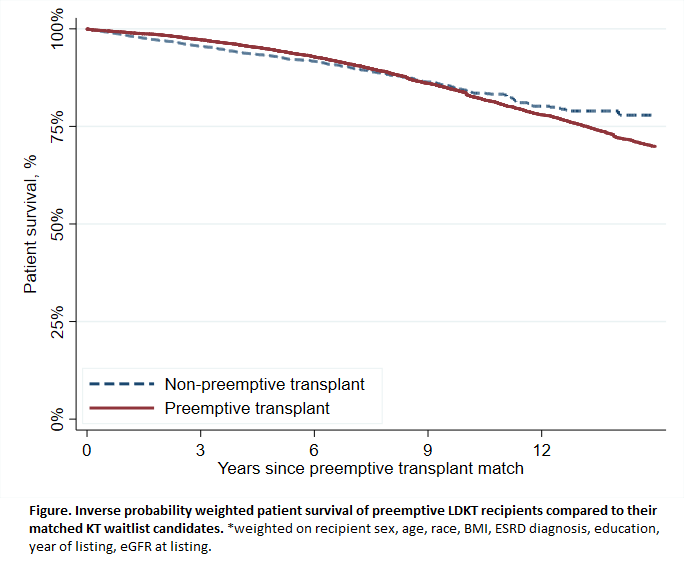To Wait or Not to Wait: The Survival Benefit of Preemptive Kidney Transplantation after Accounting for Lead Time Bias
1Johns Hopkins, Baltimore, MD, 2SRTR, Minneapolis, MN
Meeting: 2020 American Transplant Congress
Abstract number: C-079
Keywords: Kidney transplantation, Mortality
Session Information
Session Name: Poster Session C: Kidney Living Donor: Long Term Outcomes
Session Type: Poster Session
Date: Saturday, May 30, 2020
Session Time: 3:15pm-4:00pm
 Presentation Time: 3:30pm-4:00pm
Presentation Time: 3:30pm-4:00pm
Location: Virtual
*Purpose: Over 2,000 preemptive living donor kidney transplants (LDKT) per year are performed in the US. Preemptive LDKT allows recipients to avoid dialysis, but increases exposure to immunosuppression and burdens donors with longer exposure to nephrectomy. Most prior studies of the survival benefit of preemptive transplantation have failed to appropriately account for lead time, the unmeasured time between chronic kidney disease and transplantation. We sought to quantify the survival benefit of preemptive LDKT compared to waiting for an early LKDT (within 6 months of dialysis) after accounting for lead time bias.
*Methods: Using SRTR data, we studied 120,020 adult, preemptively listed kidney-only transplant (KT) candidates 2000-2017. To account for lead time bias, 27,839 preemptive LDKT recipients were 1:1 matched based on accumulated wait time to waitlist registrants who were dialysis-free at time of matching. Matched waitlist controls were censored 6 months after dialysis if not transplanted. We used Cox regression to compare the mortality risk between the two groups, with inverse probability weighting to account for confounding by candidate characteristics (age, sex, race, BMI, ESRD diagnosis, education, year of listing, and eGFR at listing).
*Results: Compared to waitlist controls, preemptive LDKT recipients were more likely to be younger, white, male, had lower BMI, and lower eGFR at listing. After weighting, there was no evidence of difference in mortality risk among preemptive LDKT recipients compared to waitlist controls (weighted HR: 0.84 0.92 1.01, P=0.1, Figure).
*Conclusions: Our findings provide no evidence that preemptive LDKT is associated with a survival benefit after accounting for lead time bias. The best timing for LDKT should be determined by risks and benefits to the donor and recipient, but not only based on a perception of survival benefit.
| Characteristics |
Preemptive transplant recipient (N=27,839) |
Matched waitlist candidates (N=27,839) |
P-value |
| Age at Listing, median (IQR) | 49 (38, 59) | 55 (45, 63) | <0.001 |
| Male | 59.1% | 55.9% | <0.001 |
| African American | 8.1% | 17.7% | <0.001 |
| BMI, median (IQR) | 27 (24, 31) | 28 (25, 33) | <0.001 |
| eGFR at listing, median (IQR) | 13 (10, 17) | 15 (12, 19) | <0.001 |
| Peak PRA, median (IQR) | 0 (0, 2) | 0 (0, 9) | <0.001 |
To cite this abstract in AMA style:
Yu S, Kernodle A, Snyder J, Garonzik-Wang J, Segev D, Massie A. To Wait or Not to Wait: The Survival Benefit of Preemptive Kidney Transplantation after Accounting for Lead Time Bias [abstract]. Am J Transplant. 2020; 20 (suppl 3). https://atcmeetingabstracts.com/abstract/to-wait-or-not-to-wait-the-survival-benefit-of-preemptive-kidney-transplantation-after-accounting-for-lead-time-bias/. Accessed July 12, 2025.« Back to 2020 American Transplant Congress

